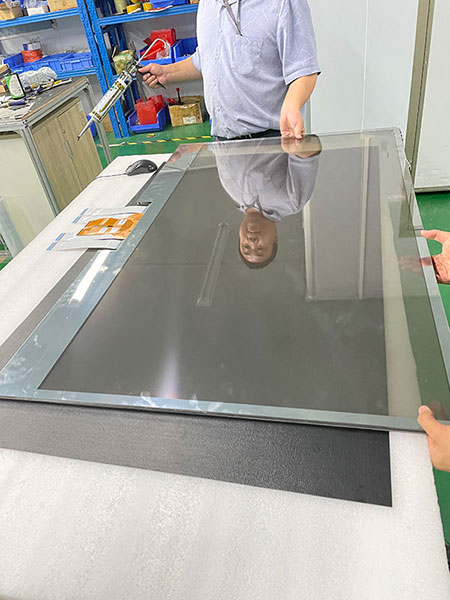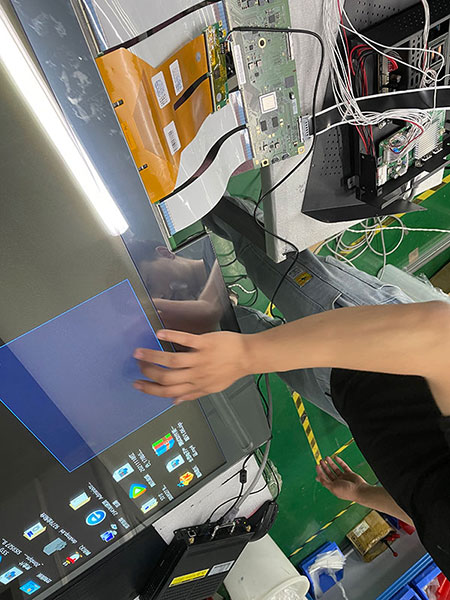Written By Mark Wang On 6th November 2022
Compared with the early development of very mature LCD (Liquid Crystal), OLED technology, as a new generation of display technology with the advantages of all-solid-state, active light, ultra-thin, bright colors, high contrast, high and low temperature performance, flexible display, etc., is known as the "global next-generation display technology", the development of the global display industry is important. The development of the global display industry is of great significance and is widely viewed by the industry.

OLED Light-emitting Process
1. TOLED device battery or power supply will apply a voltage at both ends of the OLED.
2. Current flows from the cathode to the anode and through the organic layer (current refers to the flow of electrons).
3. The cathode outputs electrons to the organic molecule emission layer.
4. The anode absorbs the electrons coming from the conduction layer of the organic molecule. (This can be regarded as the anode outputting holes to the conduction
layer, and the two effects are equal.
5. At the junction of the emitting and conducting layers, electrons will combine with holes.
6. When an electron encounters a hole, it fills the hole (it will fall into an energy level in the atom that is missing the electron).
7. This process occurs when the electron will release energy in the form of a photon.
8. OLED light-emitting.
9. The color of the light depends on the type of organic molecules in the emitting layer. Manufacturers will place several organic films on the same OLED, so that it can constitute a color display.
10. The brightness or intensity of light depends on the size of the applied current. The higher the current, the brighter the light will be.

Classification Of OLEDs
The following are several types of OLEDs: passive matrix OLEDs, active matrix OLEDs, transparent OLEDs, top-emitting OLEDs, foldable OLEDs, white OLEDs, etc.
Each type of OLED has its own unique use. Next, we will discuss each of these OLEDs, starting with passive matrix and active matrix OLEDs.
Passive Matrix OLEDs (PMOLEDs)
Passive matrix OLED structure - PMOLEDs have a cathode band, an organic layer, and an anode band. The anode band and cathode band are perpendicular to each other. The intersection of the cathode and anode forms the pixel, which is the site of light emission. An external circuit applies current to the selected cathode band and anode band, which determines which pixels emit light and which do not. In addition, the brightness of each pixel is proportional to the amount of applied current.
PMOLEDs are easy to manufacture, but they consume more power than other types of OLEDs, mainly because they require external circuitry. PMOLEDs are most efficient when used to display text and icons, and are suitable for small screens (2-3 inches diagonal), such as those often found on cell phones, PDAs, and MP3 players. Even with the presence of an external circuit, passive matrix OLEDs consume less power than the LCDs currently used in these devices.
Active Matrix OLEDs (AMOLEDs)
Active matrix OLED structure - AMOLEDs have a full cathode layer, an organic molecule layer, and an anode layer, but the anode layer is covered with a thin film transistor (TFT) array that forms a matrix. the TFT array itself is an electrical circuit that determines which pixels emit light, and thus the composition of the image.
AMOLEDs consume less power than PMOLEDs because the TFT array requires less power than external circuitry, making AMOLEDs suitable for large displays.
Transparent OLEDs
Transparent OLED structure - Transparent OLEDs have only transparent components (base, anode, cathode) and are transparent up to 85% of the base when not emitting light. When a transparent OLED display is energized, light can pass in both directions. Transparent OLED displays are available with both passive and active matrices. This technology can be used to create flat-screen displays that are mostly used in aircraft.
Top-emitting OLEDs - Top-emitting OLEDs have an opaque or reflective base layer. They are best suited for active matrix designs. Manufacturers can use top light emitting OLED displays to make smart cards.

The most important part of the OLED manufacturing process is the application of the organic layer to the substrate. There are three methods to accomplish this.
1. Vacuum deposition or vacuum thermal evaporation (VTE) - organic molecules located inside a vacuum cavity are slightly heated (evaporated) and then these molecules coalesce as a thin film on a base layer at a lower temperature. This method is very costly, but less efficient.
2. Organic Vapor Phase Deposition (OVPD) - In a low-pressure hot-wall reaction chamber, a carrier gas transports evaporated organic molecules to a low-temperature substrate, where the organic molecules then coalesce into a thin film. The use of carrier gas can improve efficiency and reduce the cost of OLED.
3. Inkjet printing - the use of inkjet technology can be OLED sprayed onto the substrate, just like printing when the ink is sprayed onto the paper. Inkjet technology greatly reduces the production cost of OLEDs, but also OLEDs can be printed on a very large surface area of the film, used to produce large displays, such as 80-inch large-screen TV or electronic signage.
This is the time to bring your projects to the next level and truly create an impact with a display that is not going to be missed. The digital signage displays are now in stock so GET IN TOUCH TODAY to reserve yours and avoid disappointment!
 Mark Wang
Mark Wang
Mark Wang is the Chief Technology Officer at CY Digital Signage. And he has over 15 years experiences in digital signage solutions.
